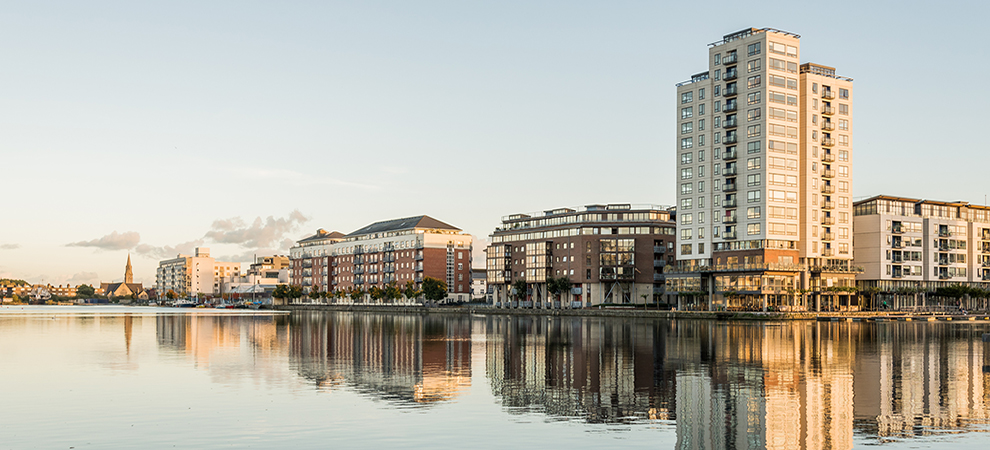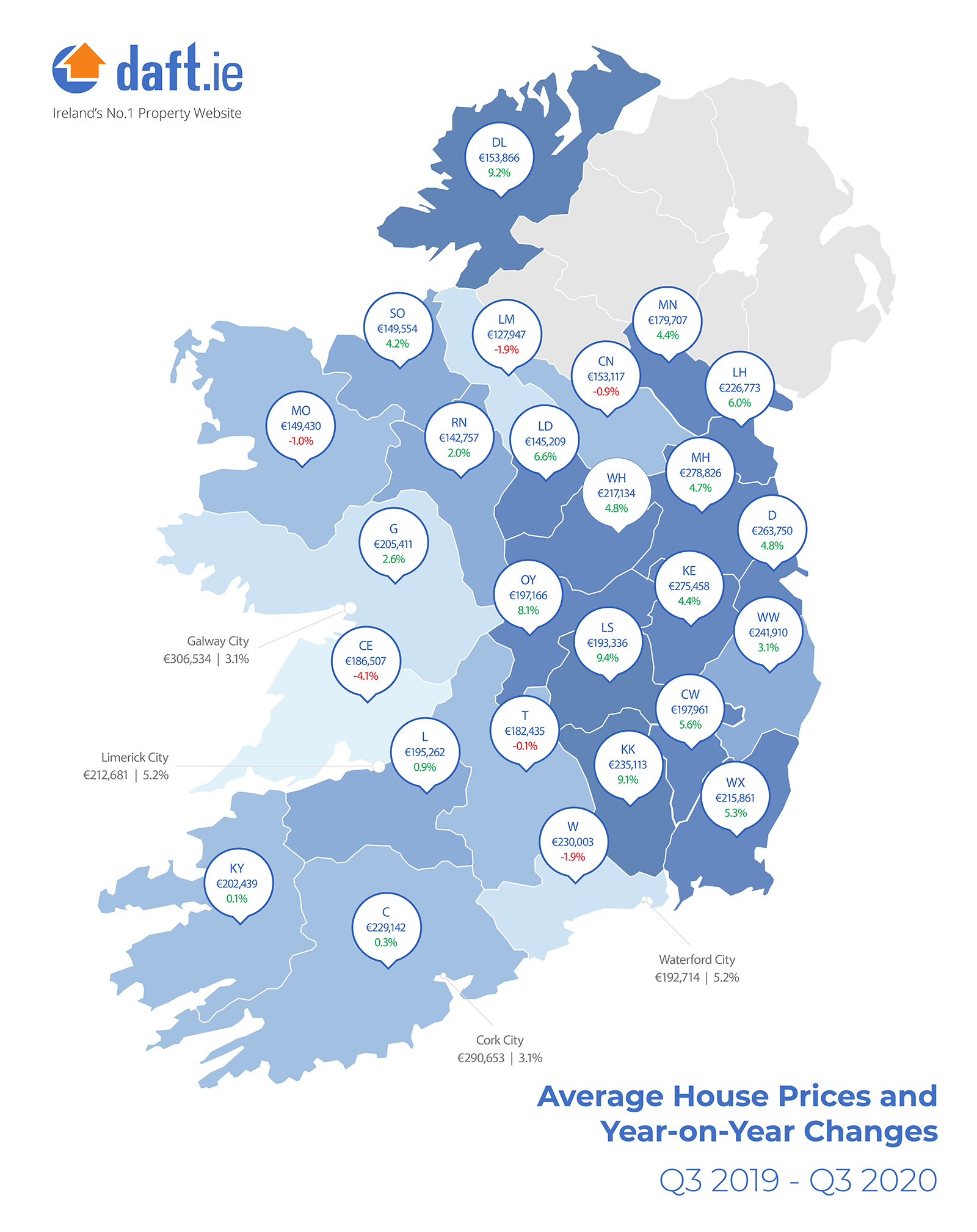The WPJ
THE WORLD PROPERTY JOURNALReal Estate Facts Not Fiction
Residential Real Estate News

Despite COVID Outbreak, Property Prices Still Rise in Ireland in Q3
Residential News » Dublin Edition | By Michael Gerrity | October 19, 2020 9:00 AM ET
According to property site Daft.ie, the average listed price of housing in Ireland rose by 4.8% between June and September 2020.
The jump offsets fell earlier in the year and means that the average sale price nationwide in the third quarter of 2020 was €263,750, up 2.7% on the same period in 2019 and 60% higher than its lowest point in early 2013.
Listed prices rose in all 54 markets contained in the Daft.ie Report between June and September, although there were significant differences around the country. The largest increases in urban areas, with prices in Waterford city rising 11%, Galway city 10% and Cork and Limerick 9% in just three months. By comparison, prices in Dublin rose by an average of 2.2%. Outside the cities, the average increase between June and September was 5.8% - with larger increases in Leinster (7.3%) and smaller increases in Connacht-Ulster (3.5%).
The number of properties available to buy on the market nationwide was just under 17,700 on October 1st, down almost one third year-on-year and the lowest figure in over 14 years. While stock on the market had improved between April 2018 and August 2019, the market has now seen 14 successive months of falling stock - with relatively similar falls in all major regions of the country.
Average list price and year-on-year change - major cities, 2020 Q3
"This highlights the underlying issue affecting the Irish housing system - a prolonged and worsening scarcity. The significant fall in completion of new homes to be registered in 2020 may prove a temporary blip. Nonetheless, the level of new home construction even in 2019 was barely half of underlying need. While the public health emergency clearly dominates policymaker attention currently, longer-term challenges should not be forgotten. Chief amongst these is the lack of housing - especially for smaller households, in or close to Ireland's largest cities and towns."
The jump offsets fell earlier in the year and means that the average sale price nationwide in the third quarter of 2020 was €263,750, up 2.7% on the same period in 2019 and 60% higher than its lowest point in early 2013.
Listed prices rose in all 54 markets contained in the Daft.ie Report between June and September, although there were significant differences around the country. The largest increases in urban areas, with prices in Waterford city rising 11%, Galway city 10% and Cork and Limerick 9% in just three months. By comparison, prices in Dublin rose by an average of 2.2%. Outside the cities, the average increase between June and September was 5.8% - with larger increases in Leinster (7.3%) and smaller increases in Connacht-Ulster (3.5%).
The number of properties available to buy on the market nationwide was just under 17,700 on October 1st, down almost one third year-on-year and the lowest figure in over 14 years. While stock on the market had improved between April 2018 and August 2019, the market has now seen 14 successive months of falling stock - with relatively similar falls in all major regions of the country.
Average list price and year-on-year change - major cities, 2020 Q3
- Dublin City: €380,731 - up 2.2%
- Cork City: €290,653 - up 3.1%
- Galway City: €306,534 - up 3.1%
- Limerick City: €212,681 - up 5.2%
- Waterford City: €192,714 - up 5.2%
"This highlights the underlying issue affecting the Irish housing system - a prolonged and worsening scarcity. The significant fall in completion of new homes to be registered in 2020 may prove a temporary blip. Nonetheless, the level of new home construction even in 2019 was barely half of underlying need. While the public health emergency clearly dominates policymaker attention currently, longer-term challenges should not be forgotten. Chief amongst these is the lack of housing - especially for smaller households, in or close to Ireland's largest cities and towns."
Sign Up Free | The WPJ Weekly Newsletter
Relevant real estate news.
Actionable market intelligence.
Right to your inbox every week.
Real Estate Listings Showcase
Related News Stories
Residential Real Estate Headlines
- Las Vegas Area Home Prices Uptick 4.3 Percent Annually in March
- Single-Family Rent Growth in U.S. Trends Upward in 2025
- U.S. Mortgage Rates Tick Down Post Trump Tariffs Commencement
- President Trump's 'Liberation Day' Tariffs Potential Impact on the U.S. Housing and Mortgage Markets
- Baby Boomers Biggest Cohort of U.S. Home Buyers in 2025 as Millennials Decline
- U.S. Monthly Housing Payments Hit Record High in 2025
- U.S. Pending Home Sales Uptick in February
- Global Prime Residential Rent Slowdown Continued in Late 2024
- Ireland Home Price Inflation Hits 8 Year High in Early 2025
- Existing Home Sales in America Uptick in February
- Great Miami Area Residential Sales Decline 15 Percent Annually in February
- Mortgage Rates Uptick in Mid-March, Ending 9-Week Decline in U.S.
- World Property Ventures Builds the Future of Real Estate with New Funding Round
- U.S. Builder Sentiment Declines Amid Economic Uncertainty and Rising Costs
- Black Homeownership Rates in U.S. Enjoy Largest Annual Increase of All Racial Groups
- Wealthy Renters Are Taking Over More of the U.S. Rental Market
- If U.S. Congress Does Not Extend NFIP Soon, Thousands of Daily Home Closings Impacted
- U.S. Mortgage Applications Spike 11 Percent in Early March
- Greater Palm Beach Area Residential Sales Rise in Early 2025
- New Apartments in U.S. Are Leasing at Slowest Pace on Record
- U.S. Mortgage Rates Drop to 4 Month Low in March
- Overall U.S. Mortgage Delinquency Rates Dip in December
- New Tariffs on Canada, Mexico to Impact U.S. Homebuilder Input Costs
- Monaco's Property Market: A Tale of Two Cities
- U.S. Home Purchase Cancellations Surge, 1 in 7 Sales Getting Canceled
- U.S. Pending Home Sales Hit Historic Low in Early 2025
- Greater Miami Area Residential Sales Dip in January
- Governor DeSantis Supports Ending Property Taxes in Florida
- WPV Aims to Become the Berkshire Hathaway of Real Estate Tech
- U.S. Home Sales Slump Continues in January
- Average Americans Spend 38 Percent of Monthly Income on Mortgage Payments
- Switzerland's Safe-Haven Appeal Grows with World's Wealthy Homebuyers
- U.S. Builder Confidence Rapidly Declines in February
- Las Vegas Home Sales Rise 6.7 Percent Annually in January, Condo Sales Dip
- Homebuyer Demand in America Drops to 5-Year Low in Early 2025
- Ownership More Affordable Than Renting in Most U.S. Markets
- The World's First Global Listings Service Launches, Called a GLS
- Home Prices Continue to Rise in 89 Percent of U.S. Metros in Late 2024
- Global Luxury Residential Prices Showed Gradual Improvement in Late 2024
- U.S. Construction Hiring Rate Drops to Lowest Levels in 5 Years
Reader Poll
Marketplace Links
This website uses cookies to improve user experience. By using our website you consent in accordance with our Cookie Policy. Read More






